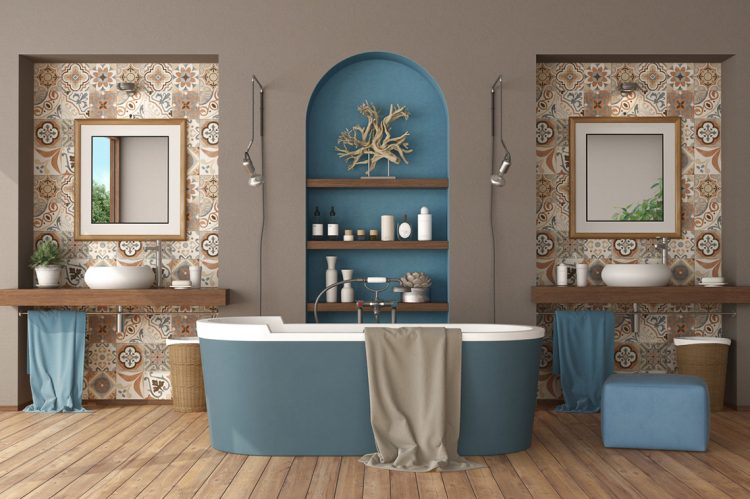Staging a home can be one of the most effective ways to attract potential buyers to a property. As we take on the spring selling season, understanding and implementing new design trends to include in your home staging can give your sellers a competitive edge and help them achieve a faster, more successful sale.
But before you spend a pretty penny on furniture, art or other decor elements, or a home staging service to stage your properties, it’s important that you’re aware of the latest trends and styles that today’s buyers are looking for. This will not only ensure that your client’s home is presented in a modern, stylish light, but it will also showcase your knowledge and skill for providing potential buyers with an immersive and relatable experience.
Bonus Tip: If physically staging a for-sale property is not in your budget, or simply not your thing, try virtual staging. Check out this recent RISMedia article, How to Leverage Virtual Staging for Your Listings (And Why it Works), for more information.
With schedules filled with listing appointments, open houses and lead generation efforts, it can be tough for real estate professionals to have a finger on the pulse of home design trends. So, we did it for you!
Taking a look at houzz, a platform for homeowners, home design enthusiasts and home improvement professionals to explore and share design ideas, research and hire home professionals and discover new products, we were able to gain insight into the latest home improvement projects being tackled today, as well as emerging home design styles and trends that stand to be popular in 2023, directly from the consumer’s perspective.
Some of the top home design trends for 2023, according to houzz, include:
- For Kitchens: Modern Rustic Style
- Natural materials and a general feeling of warmth top the list for today’s most favored kitchens. Natural wood cabinets, natural stone countertops combined with modern elements, such as hardware and black details, complete this style.
- For Bathrooms: Contrasting Colors
- While all-white bathroom finishes continue to dominate homeowners’ choices, more and more people are adding in dark, contrasting colors. From darker cabinets to visually interesting accent tiles, a touch of drama in this space is gaining popularity.
- For Bedrooms: Dark Millwork Accent Walls
- Similar to bathrooms, adding darker tones to a bedroom is gaining traction in this space. Millwork is also becoming a popular choice, paired with darker colors, to add depth, drama and a focal feature.
- For Living Rooms: Connection to the Outdoors
- More and more homeowners are craving ways to bring the outdoors inside. Adding larger windows that allow for more natural light, wallpaper with prints that recall nature, and a focus on natural materials and accessories, especially houseplants, are on the rise.
- For Home Offices: Built-In Storage
- The post-pandemic landscape has placed home/work spaces in the spotlight, where organization has become a top priority. Custom built-ins are often the go-to, adding storage and display options without overwhelming the style of the room.
- For Outdoor Spaces: Sustainability
- Though the desire for sustainable materials has been common over the last few years, there has been an intense shift in the last year. Longer-lasting materials, water-saving features, energy-efficient appliances and environmentally-friendly sourced materials are among the sustainable features homeowners are turning to.
Pinterest is another consumer-focused platform where users can explore, share and save ideas. For many, Pinterest offers a way to imagine and illustrate your desires and plans for the future. Recently, Pinterest released the 2023 Pinterest Predicts Report, described as a window into the future from the place where people go to plan it. They even claim that for the last three years, 80% of the report predictions came true, including the top trends in home design and decor.
When it comes to the home, here are some of the top home design-related topics and trends that users from all different generations are searching for the most, according to Pinterest:
- Highlighting Showers as the Star of the Bathroom. Boomers and Gen Xers are ignoring traditional bathtubs, searching for topics such as home spa bathrooms (+190%), shower bombs (+90%) and routines (+450%), and doorless shower ideas (+110%).
- Combining Vintage and Modern Styles. Boomers and Gen Zers are finding new ways to honor old items in their homes, searching for topics such as mixing modern and vintage furniture (+530%), antique windows repurposed (+50%) and eclectic interior design vintage (+850%).
- Putting a Spotlight on the Front Porch. Boomers and Gen Xers are embellishing front doors and adorning home entrances, searching for topics such as front door transformation (+85%), garden front of house entrance (+35%) and foyer entryway decor ideas (+190%).
- Expanding Unique and Unusual Design Styles. Boomers and Gen Zers are welcoming designs and styles that are anything but ordinary, searching for topics such as funky house decor (+695%), weirdcore bedroom (+540%) and fantasy mushroom art (+170%).
- Finding Natural, Sustainable Solutions. Boomers and Gen Xers are highlighting the importance of water conservation, searching for topics such as drought tolerant landscape design (+385%), rain water harvesting architecture (+155%), rock drainage landscaping (+70%) and rain chain drainage (+35%).
Overall, sustainability, mixing modern and vintage styles, and rethinking bathroom spaces are among some of the top trends that consumers are searching for and interested in this year. Whether you’re planning to suggest updates to your sellers, or looking to traditionally or virtually stage a property, these trends should remain top of mind when it comes to attracting today’s homebuyers.
By incorporating top design trends into your home staging, it not only showcases a property’s potential as a home, but it highlights your understanding of your clients’ needs, interests and expectations.
The National Association of REALTORS® (NAR) recently released its 2023 Profile of Home Staging, which explores and reveals the role that home staging plays in a real estate transaction. It also includes information from buyer’s and seller’s agents, shedding light on the expectations of today’s buyers as well.
Brandi Snowden, director of Member and Consumer Survey Research for NAR, shared her insights on key findings in the report. She also discussed how these findings will impact the industry throughout 2023.
“In this report, we take a look at home staging from our member’s perspective, from both the buyer’s and seller’s agent side, and we also ask our members about some of their recent interactions with their clients,” says Snowden.
“For our members who are buyer’s agents, we asked about how staging affects their buyer’s view about different homes. More than half of our members, 58%, found that staging has an effect on most of their buyers, and some of these impacts most often included making the property easier to visualize as their future home. They might also be more willing to walk through a home they have only seen online before. If a home is staged or decorated to a buyer’s taste, that will also positively impact the home’s value.
“From the seller’s agent perspective, we found that about 50% of our members do not stage all of their homes, but they may suggest decluttering the home, having the entire home professionally cleaned, removing pets during showings, having professional photos taken and making some minor repairs, to their home sellers,” she continues.
The profile offers many insights from both sides of the transaction, and real estate professionals can leverage this information to improve both their sales strategies and the consumer experience.
“It’s always interesting to see how other agents are taking on home staging, including how home staging is increasing the dollar value for their homes,” says Snowden. “It’s always helpful to see how they can help their prospective clients, including their expectations, where they want to live and what they want from their ideal home, then they will be better able to help them find that great property. It is helpful for agents on both sides to have this data and understand how to meet their client’s needs.”
In addition to helping buyer’s and seller’s agents, the report can also be a great source of information for professional home stagers.
“Home stagers can definitely use the support on the buyer’s and seller’s side. This year, we asked not just about traditional staging, but virtual staging, which we continue to see become more popular,” Snowden continues. “If home stagers are looking for other options for staging and have never tried virtual staging before, being able to see that other members are utilizing these virtual staging options may help them become more willing to try it for themselves.”
The 2023 Profile of Home Staging notes that staging, especially virtual staging, has become more important in recent years. Though this was the first year that virtual staging was included in the report, Snowden expects to see it continue to become of greater importance to both agents and their clients.
Home staging in general, whether traditional or virtual, has also shown to help homes sell faster.
“The report showed us that 27% of our seller’s agents said that a staged home slightly decreased the time it was on the market, and 21% said that it greatly decreased the time on the market,” says Snowden. “We expect to see similar trends in the future, especially with virtual staging options.”
When it comes to client expectations, it’s important for both buyer and seller’s agents to understand them. The report also highlights the effects of television shows, how they might be influencing consumers and, as a result, what today’s buyers and sellers expect when searching, viewing, buying and selling homes.
“About 5% of our respondents said that their buyers believe that homes should be staged like they are on TV. We also saw that about 10% of respondents said their buyers would be disappointed in how homes look in person compared to what they see on TV,” says Snowden.
“We also asked about TV shows that are displaying the home-buying process, and if that has an impact. Twenty-four percent of our members stated that their businesses might be impacted by these types of shows, but also looking at the impact these shows might be having, our members reported that they might set unrealistic or increased expectations for how homes might be expected to look,” adds Snowden.
“Fifty-five percent said that their clients might have higher expectations of how homes should look, but it is also interesting to see that 26% reported that their homebuyers and home sellers might be more educated on the home-buying process because of these shows—a positive impact from these shows,” she continues.
Heading into the future, home staging is clearly becoming a significant tool for agents, their clients and potential homebuyers. Snowden believes that next year’s report will dive deeper into virtual staging and whether this tool increases in importance, looking into the significance of staging different rooms and spaces within a home in order to attract potential clients.
From understanding emerging trends to implementing these trends into home staging designs, you can not only improve the client experience, but also set yourself up to become more competitive in your market.












